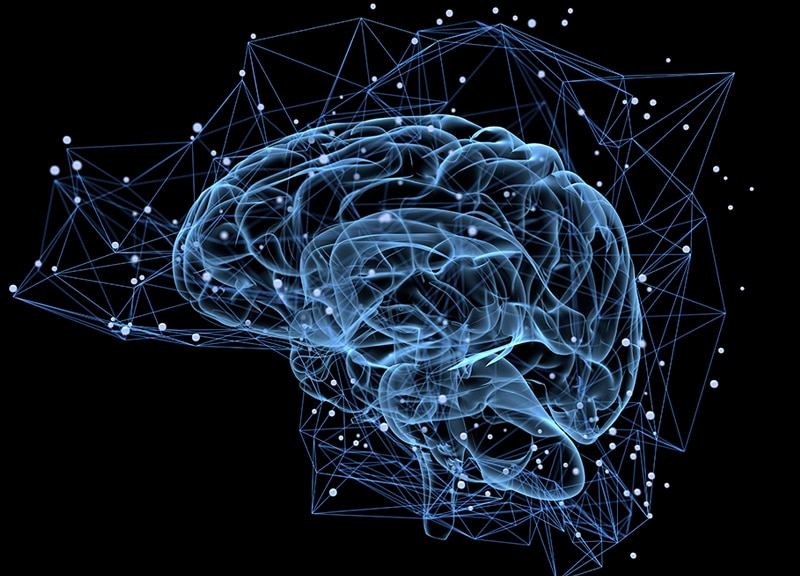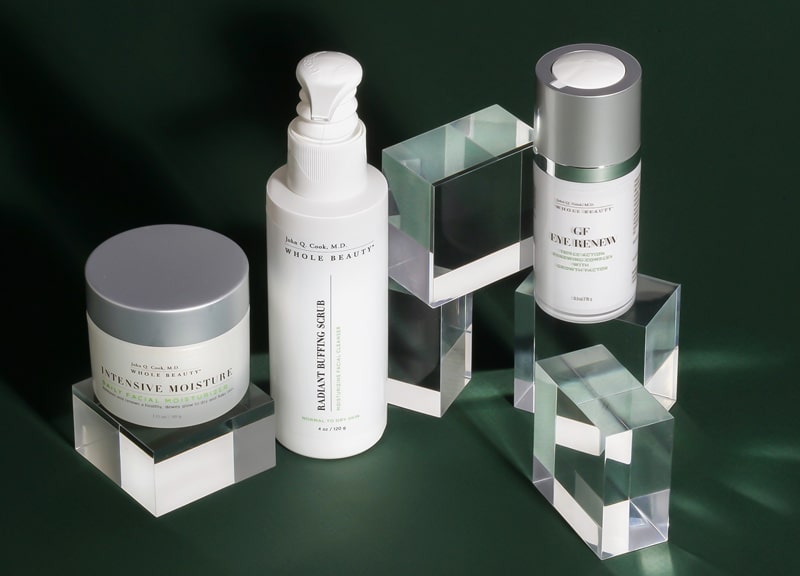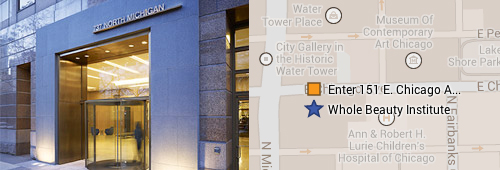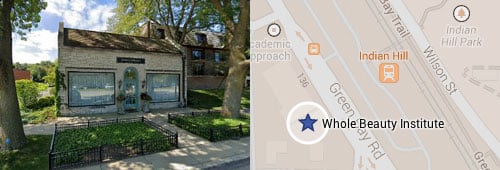Education and Credentials

Awards and Recognition

REAL PATIENT RESULTS
See the difference experience makes. View the full before & after photo gallery of Dr. Cook and his team.
Skin Resurfacing Basics and Glossary
Learn How Technology Has Developed to Create the Treatments used in Chicago and Winnetka
There are many technologies designed to diminish fine lines and wrinkles on the face, neck, and other areas. Patients who come to see Dr. John Q. Cook and the Whole Beauty® Institute team for skin resurfacing in Chicago and Winnetka have often been to a variety of different doctors, each offering a different machine that will supposedly work miracles. The purpose of this discussion is to demystify the process of skin resurfacing so that you can make an informed choice.

Contact Whole Beauty® Institute to arrange a consultation for skin resurfacing in Chicago or Winnetka. Call 312-751-2112 or send a message online.
Request a consultThe Fundamental Mechanism Behind All Skin Resurfacing Treatments
Whether it’s deep chemical peels, erbium laser skin resurfacing, HALO fractional laser®, MOXI® , radiofrequency-powered Morpheus®, or Fractora® every method of skin resurfacing seeks to trigger the skin’s own natural process of healing and regeneration.
In the days of old, before there were physicians and hospitals, our bodies had to rely on their own internal method of repair if there was an injury. If a wild animal swiped you with its claws or you scraped your leg against a rock, the body’s natural repair system immediately went into overdrive. This repair mechanism has kept our species alive to this very day.
The early forms of skin resurfacing—such as deep dermabrasion, first-generation laser resurfacing, and deep peels—triggered the natural healing mechanism in the dermis (the deepest layer of the skin), but they did so at a price. In order to injure or heat the dermis and trigger the healing response, they removed the entire epidermis of the treated area. The patient was left with an open wound that often took weeks to heal.
Fractional resurfacing technology largely preserves the epidermis, allowing for much quicker healing. Various devices can poke hoes in the epidermis to reach the dermis and stimulate the healing response.
The Two Main Layers of the Skin
The skin has two main layers. The epidermis is the outer layer of tightly packed layers of cells and serves as an automatically renewing barrier against the external environment. It renews itself every 30 days or so as cells move upward from the deep basal layer to the top keratin layer.
The inner layer, the dermis, is made up of a moist and springy combination of collagen, elastin, and hyaluronic acid. There are factory cells within the dermis that produce these substances. For more detail on this, please visit Dr. Cook’s blog on this topic.
All methods of skin resurfacing seek to trigger the factory cells of the dermis so that they go into healing and repair mode, plumping up the skin with all the extra collagen, elastin, and hyaluronic acid that they produce. As the dermis gets plumper, the wrinkles disappear—or at least diminish. It’s that simple.
Skin Resurfacing Glossary
Dr. Cook put together this glossary to help you understand the often-confusing terms used to define various skin resurfacing techniques.
Skin Resurfacing
Any method that has as its goal a restoration of youthful structure to the skin. This includes a wellorganized structure to the epidermis, the outer layer of the skin, and to the dermis, the deeper springy layer of the skin, which thins out as we age.
Chemical Peel
This skin resurfacing treatment involves the application of a substance to the skin to freshen the appearance. The effects of peels vary with the strength of the solution and the material used. The mildest peels simply clean off the outer layer of the skin to impart a fresher appearance. The deepest peels can be much more powerful and produce changes in the epidermis and the dermis that, in many ways, revert to the structure of youthful skin. This is done at a price, since the outer layer of the skin is removed and a prolonged healing time is required. Intermediate-level peels can produce many benefits with a milder healing process.
TCA Peel
This widely used peel technique can be used to freshen the outer layer of the skin or reach the deeper layers, depending on concentration and amount of application. This peel, which uses a chemical of very simple structure, works very well around the eyelids and mouth, but can also be used for the entire face. Before the advent of laser skin resurfacing, TCA peels were the workhorse of skin resurfacing. TCA forms the basis of the popular Obagi® peel, which simply combines TCA with an indicator that tells the person applying the peel when to stop.
Phenol/Croton Oil Peel
In many ways the gold standard for resurfacing results, a precisely designed phenol/croton oil peel can produce remarkable changes in the skin. It does not depend upon expensive technology. That said, the peel suffers from two downsides: First, it requires a great degree of skill in its use. Second, there is a prolonged period of recovery. For these reasons, it is used less commonly than other skin resurfacing methods.
Deep Dermabrasion
One of the first methods of skin resurfacing, dermabrasion has been around for decades and employs a rotating diamond-covered wheel or metal brush to sand down the outer layer of the skin and reach areas of irregularities in the dermis. Dermatologists and plastic surgeons use dermabrasion most commonly to smooth out areas of acne scarring and to soften the wrinkles (smokers’ lines) that occur around the mouth. To reach these deeper areas, the physician must remove much of the epidermis, so a relatively long healing time is required.
Microdermabrasion
This newer version of dermabrasion uses air to jet a fine stream of crystals that abrade the surface of the skin. There are also versions that avoid the use of crystals. This treatment can help to refine the quality of the skin and, in the hands of a skilled practitioner, soften fine lines and scars and remove brown patches from the skin. The technique is often combined with other methods of skin therapy, such as the application of beneficial compounds to the skin. There is a wide range of power and efficacy with these techniques. Spa-grade machines work at relatively modest settings and produce modest but pleasant results. More powerful results can occur when medical-grade equipment is used, but a skilled operator and medical environment provide the best outcome.
Dermaplaning
This is a nonsurgical skin resurfacing treatment performed with a special blade held at 45 degree angle to remove rough, dry, and dead skin cells from the epidermis. The procedure can be performed in small, precise areas or applied to the full facial area. There are no chemicals applied, so it is an ideal exfoliation treatment for sensitive skin.
Laser Skin Resurfacing
Laser energy has many useful medical applications. By definition, a laser is an amplified beam of light of a single wavelength that follows a straight line path. Although there is a good deal of obfuscation about this technology, the concept is simple. Laser energy targets water in the skin and denatures the protein of the surface protective layer (the epidermis), heating the dermis to stimulate a healing response. First-generation CO2 laser machines produced powerful results with light at a 1064nm wavelength, but required a prolonged down time for healing. There were also problems for some patients, who experienced changes in skin pigment quality, so that the treated area appeared lighter or darker than adjacent areas. To diminish these problems, companies developed the erbium laser (2940nm wavelength), designed to deliver short bursts of energy and limit collateral damage. Early erbium machines produced excessive bleeding and didn’t stimulate the dermis as well as expected, so combined short and long pulse machines were developed.
Fractional Skin Resurfacing
For decades, doctors involved in skin resurfacing were frustrated by the fact that it really wasn’t desirable or even necessary to destroy the epidermis in order to reach the dermis and stimulate the healing response—and that there wasn’t a way to avoid this collateral damage. Some very bright people came up with the idea of fractional laser skin resurfacing, which uses advanced technology to make tiny holes in the skin. A laser beam creates a precise pattern with energy passing through these holes to heat the dermis and stimulate the healing response, but it leaves the spaces between the holes intact, so there is much less damage to the epidermis. The result is a much quicker healing time than with first-generation laser skin resurfacing. The HALO® hybrid fractional laser combines two different lasers, erbium (2940) and diode (1470), for a particularly powerful effect.
Ablative, Nonablative, and Microablative Skin Resurfacing
These off-putting terms seem designed by the laser companies to mystify a straightforward concept. They simply refer to whether you remove (ablative), keep intact (nonablative), or partially remove (micoablative) the surface of the skin when you stimulate the healing response in the dermis.
Read More...
Ablative skin resurfacing includes all forms of traditional CO2 and erbium lasers, deep peels, and deep dermabrasion.
Nonablative skin resurfacing includes a wide variety of technologies, which can be laser based, radiofrequency based, or use other energy sources. The point is that they leave the skin intact or just with tiny holes so that healing time after treatment is very short. The term is used to describe two types of devices: Some focus a beam of energy on the dermis and leave the epidermis intact, while others create tiny holes in the epidermis to reach the dermis. The earliest nonablative skin resurfacing systems produced moderate but not spectacular improvement with essentially no recovery time. In order to boost the power, several companies have developed fractional nonablative technologies, which prick tiny holes in the skin and allow a greater amount of energy to be delivered to deeper structures. One nice example of nonablative skin resurfacing is the Moxy® device, which is well suited to patients with relatively early skin damage.
Microablative skin resurfacing seeks a middle ground between the power of fully ablative skin resurfacing (i.e. traditional CO2 laser resurfacing with powerful results but weeks of downtime) and the diminished power of true nonablative fractional resurfacing (with more limited results and very little downtime). In this approach, which typically employs fractional technology, a greater amount of the skin surface is damaged and a bigger dose of energy is sent to the dermis. In other words, a greater amount of injury is inflicted to trigger a proportionately greater healing response. The tradeoff is that the patient has to experience several days—at least—of raw and irritated skin, but the recovery is still not as severe as with traditional ablative methods. The overall results can be lovely, but still don’t approach the power of fully ablative methods in treating severely damaged skin.
A Closer Look at Lasers and Skin Resurfacing
Just when you thought this was all making sense, some laser companies have added more jargon. Currently, patients seeking skin resurfacing may hear about what are being marketed as ablative fractional laser systems.
From Dr. Cook’s perspective, this is an inaccuracy that just confuses patients (and many physicians). The whole purpose of fractional resurfacing is that it is not fully ablative! If it were, this would mean that the entire surface of the skin has been removed, in which case we would have come full circle to the methods of 20 years ago where we got big results, but we inflicted big damage.
Ablative Fractional Skin Resurfacing
This nonsense term is commonly used by laser companies to describe microablative fractional resurfacing.
Nonablative Fractional Skin Resurfacing
The use of fractional technology usually coupled with a laser energy source that either passes through the epidermis entirely or makes tiny holes in the skin in a computer-generated pattern to stimulate the healing process in the dermis and the deeper layers of the skin.
Micoablative Fractional Skin Resurfacing
This is similar to nonablative fractional skin resurfacing, but a greater amount of the skin surface is damaged and greater energy is delivered to the deeper layers. This leads to a more powerful result, but with a longer recovery period than experienced with nonablative fractional skin resurfacing. It can also help to improve the structure of the epidermis with some devices.
A Closer Look at Radiofrequency Energy and Skin Resurfacing
Radiofrequency energy can be used to stimulate the repair mechanism of the skin. This energy is in the part of the electromagnetic spectrum that includes radio waves. It has a longer wavelength than visible light (which includes laser energy) and has been used in medical applications for decades, but has become increasingly popular for skin applications in the last few years.
Unipolar Radiofrequency Skin Resurfacing
Radiofrequency energy is directed into the skin to heat the deeper tissues and initiate the healing response and skin tightening.
Bipolar Radiofrequency Skin Skin Resurfacing
Radiofrequency energy can be designed to flow between positive and negative electrodes, so that it follows a path through the skin. This allows the energy to be precisely focused. This is the technology behind the Forma® handpiece.
Fractional Bipolar Radiofrequency Skin Resurfacing
This is the design of the Fractora® system. Since it is a bipolar system, it allows energy to flow between pins in the center of the hand-piece and plates on the sides of the hand-piece. The farther the pin is from the plate, the deeper the energy goes. This provides a very uniform distribution of energy through the dermis.

If you would like to have a consultation regarding skin resurfacing in the Chicago area, or if you have questions for our team, please call 312-751-2112 or contact us online.
Request a consult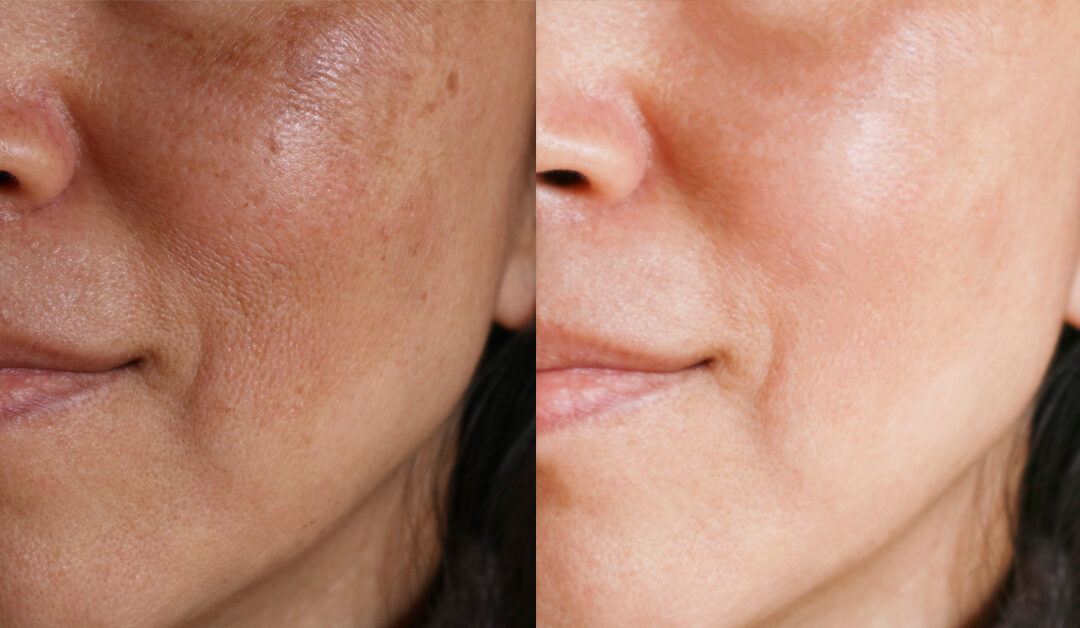
What Are the Benefits of Fractional Lasers?
When you’re selecting a laser treatment, it’s always best to start by focusing on your goals....

Why Winter Makes Sense for Facial Laser, IPL and Radiofrequency Treatments
In the midst of another Chicago winter, you may be wishing for spring and summer. Chicagoans love...

Winter Is the Time to Bare Your Legs
Winter is a time when most people give little thought to laser hair removal treatments. The...
Practice Blog
Learn more about Dr. John Q. Cook and the non-surgical treatments and plastic surgery procedures available at The Whole Beauty® Institute. Get tips and advice, discover new ways to improve your health and beauty, and more.
Dr. Cook's HealthGems Blog
Dr. John Q. Cook shares his personal thoughts on well-being, quality of life, and more—all drawn from his decades of experience in the industry, studying and working with advanced technology and techniques.
Whole Beauty Skincare
SkinShopMD was created by board-certified plastic surgeon John Q. Cook, M.D. as a trusted source for skin care products. From his years of experience, he developed a portfolio of high quality medical grade products to protect and rejuvenate your skin.
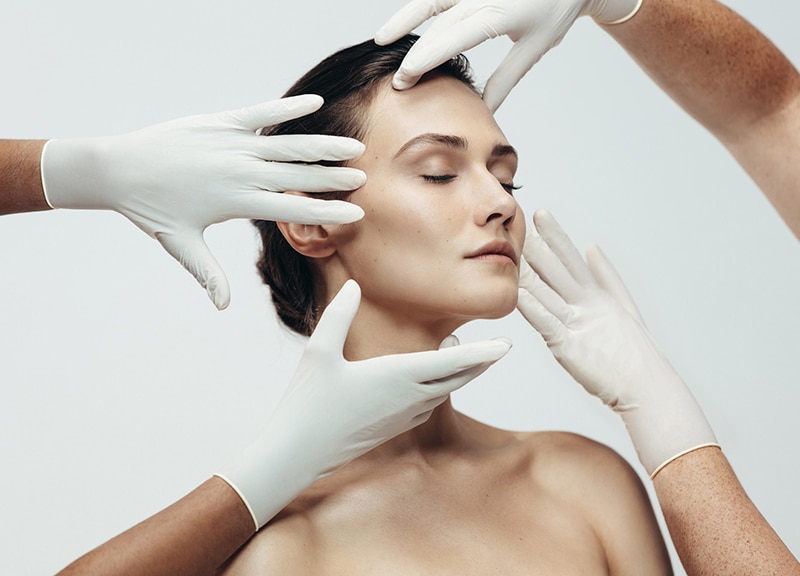
Educational Information
Learn important information about surgical and non-surgical procedures to help you make informed decisions about your desired treatment based on your goals. Topics cover facial surgery, injectables, lasers, breast surgery, body contouring, and other treatments.
Testimonial and Practice Videos
Schedule a Consultation
Schedule a consultation with board-certified plastic surgeon, John Q. Cook, M.D., to learn more about plastic surgery solutions that may be right for you based on your aesthetic goals.
"*" indicates required fields
Our Office Locations
Our locations in the Gold Coast of Chicago and Winnetka in the North Shore reflect our commitment to convenient and discrete concierge-level service.
Chicago Office
737 North Michigan Ave., Suite 760 Chicago IL 60611 (312) 751-2112 Entrance at 151 E. Chicago Avenue
Winnetka Office
118 Green Bay Road Winnetka IL 60093 (847) 446-7562
Located directly across from Indian Hill Metra Station




